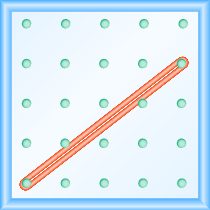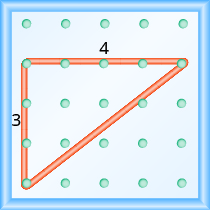Using Models to Define Slope
Learning Outcomes
- Use a model to determine slope
- Create a model of slope
In this section, we will explore the concepts of slope. Using rubber bands on a geoboard gives a concrete way to model lines on a coordinate grid. By stretching a rubber band between two pegs on a geoboard, we can discover how to find the slope of a line. And when you ride a bicycle, you feel the slope as you pump uphill or coast downhill.
Doing the Manipulative Mathematics activity "Exploring Slope" will help you develop a better understanding of the slope of a line. We’ll start by stretching a rubber band between two pegs to make a line as shown in the image below. Does it look like a line?
Now we stretch one part of the rubber band straight up from the left peg and around a third peg to make the sides of a right triangle as shown in the image below. We carefully make a [latex]90^ \circ [/latex] angle around the third peg, so that one side is vertical and the other is horizontal.
Does it look like a line?
Now we stretch one part of the rubber band straight up from the left peg and around a third peg to make the sides of a right triangle as shown in the image below. We carefully make a [latex]90^ \circ [/latex] angle around the third peg, so that one side is vertical and the other is horizontal.
 To find the slope of the line, we measure the distance along the vertical and horizontal legs of the triangle. The vertical distance is called the rise and the horizontal distance is called the run, as shown below.
To find the slope of the line, we measure the distance along the vertical and horizontal legs of the triangle. The vertical distance is called the rise and the horizontal distance is called the run, as shown below.
 To help remember the terms, it may help to think of the images shown below.
To help remember the terms, it may help to think of the images shown below.
 On our geoboard, the rise is [latex]2[/latex] units because the rubber band goes up [latex]2[/latex] spaces on the vertical leg. See the image below.
What is the run? Be sure to count the spaces between the pegs rather than the pegs themselves! The rubber band goes across [latex]3[/latex] spaces on the horizontal leg, so the run is [latex]3[/latex] units.
On our geoboard, the rise is [latex]2[/latex] units because the rubber band goes up [latex]2[/latex] spaces on the vertical leg. See the image below.
What is the run? Be sure to count the spaces between the pegs rather than the pegs themselves! The rubber band goes across [latex]3[/latex] spaces on the horizontal leg, so the run is [latex]3[/latex] units.
 The slope of a line is the ratio of the rise to the run. So the slope of our line is [latex]\frac{2}{3}[/latex]. In mathematics, the slope is always represented by the letter [latex]m[/latex].
The slope of a line is the ratio of the rise to the run. So the slope of our line is [latex]\frac{2}{3}[/latex]. In mathematics, the slope is always represented by the letter [latex]m[/latex].
Slope of a line
The slope of a line is [latex]m=\frac{\text{rise}}{\text{run}}[/latex]. The rise measures the vertical change and the run measures the horizontal change.example
What is the slope of the line on the geoboard shown? Solution
Use the definition of slope.
[latex-display]m=\frac{\text{rise}}{\text{run}}[/latex-display]
Start at the left peg and make a right triangle by stretching the rubber band up and to the right to reach the second peg.
Count the rise and the run as shown.
Solution
Use the definition of slope.
[latex-display]m=\frac{\text{rise}}{\text{run}}[/latex-display]
Start at the left peg and make a right triangle by stretching the rubber band up and to the right to reach the second peg.
Count the rise and the run as shown.
 [latex-display]\begin{array}{cccc}\text{The rise is }3\text{units}.\hfill & & & m=\frac{3}{\text{run}}\hfill \\ \text{The run is}4\text{units}.\hfill & & & m=\frac{3}{4}\hfill \\ & & & \text{The slope is }\frac{3}{4}.\hfill \end{array}[/latex-display]
[latex-display]\begin{array}{cccc}\text{The rise is }3\text{units}.\hfill & & & m=\frac{3}{\text{run}}\hfill \\ \text{The run is}4\text{units}.\hfill & & & m=\frac{3}{4}\hfill \\ & & & \text{The slope is }\frac{3}{4}.\hfill \end{array}[/latex-display]
example
What is the slope of the line on the geoboard shown?
Answer:
Solution
Use the definition of slope.
[latex-display]m=\frac{\text{rise}}{\text{run}}[/latex-display]
Start at the left peg and make a right triangle by stretching the rubber band to the peg on the right. This time we need to stretch the rubber band down to make the vertical leg, so the rise is negative.
 [latex-display]\begin{array}{cccc}\text{The rise is }-1.\hfill & & & m=\frac{-1}{\text{run}}\hfill \\ \text{The run is}3.\hfill & & & m=\frac{-1}{3}\hfill \\ & & & m=-\frac{1}{3}\hfill \\ & & & \text{The slope is }-\frac{1}{3}.\hfill \end{array}[/latex-display]
[latex-display]\begin{array}{cccc}\text{The rise is }-1.\hfill & & & m=\frac{-1}{\text{run}}\hfill \\ \text{The run is}3.\hfill & & & m=\frac{-1}{3}\hfill \\ & & & m=-\frac{1}{3}\hfill \\ & & & \text{The slope is }-\frac{1}{3}.\hfill \end{array}[/latex-display]
try it
[ohm_question]147013[/ohm_question] As you read from left to right, the line in Figure A, is going up; it has positive slope. The line Figure B is going down; it has negative slope.
As you read from left to right, the line in Figure A, is going up; it has positive slope. The line Figure B is going down; it has negative slope.

example
Use a geoboard to model a line with slope [latex]\frac{1}{2}[/latex].Answer: Solution To model a line with a specific slope on a geoboard, we need to know the rise and the run.
| Use the slope formula. | [latex]m=\frac{\text{rise}}{\text{run}}[/latex] |
| Replace [latex]m[/latex] with [latex]\frac{1}{2}[/latex] . | [latex]\frac{1}{2}=\frac{\text{rise}}{\text{run}}[/latex] |
 The hypotenuse of the right triangle formed by the rubber band represents a line with a slope of [latex]\frac{1}{2}[/latex].
The hypotenuse of the right triangle formed by the rubber band represents a line with a slope of [latex]\frac{1}{2}[/latex].
try it
Use a geoboard to model a line with the given slope: [latex]m=\frac{1}{3}[/latex].Answer:

Answer:

example
Use a geoboard to model a line with slope [latex]\frac{-1}{4}[/latex]Answer: Solution
| Use the slope formula. | [latex]m=\frac{\text{rise}}{\text{run}}[/latex] |
| Replace [latex]m[/latex] with [latex]-\frac{1}{4}[/latex] . | [latex]-\frac{1}{4}=\frac{\text{rise}}{\text{run}}[/latex] |
 The hypotenuse of the right triangle formed by the rubber band represents a line whose slope is [latex]-\frac{1}{4}[/latex].
The hypotenuse of the right triangle formed by the rubber band represents a line whose slope is [latex]-\frac{1}{4}[/latex].
try it
Use a geoboard to model a line with the given slope: [latex]m=\frac{-3}{2}[/latex].Answer:

Answer:

Licenses & Attributions
CC licensed content, Original
- Question ID 147013. Authored by: Lumen Learning. License: CC BY: Attribution.
CC licensed content, Specific attribution
- Prealgebra. Provided by: OpenStax License: CC BY: Attribution. License terms: Download for free at http://cnx.org/contents/[email protected].
